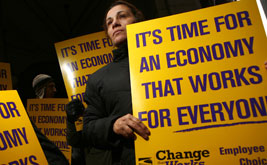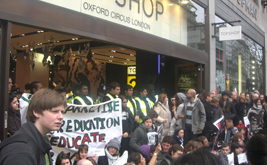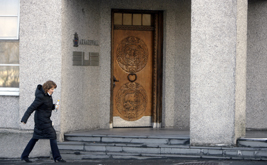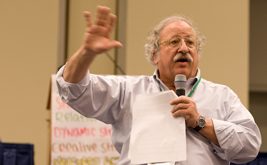
Indignez-vous! Indignez-vous!
In the first English translation of a cri de coeur that has topped bestseller lists for months in France, the 93-year-old hero of the French Resistance urges a new generation to re...
Feb 16, 2011 / Feature / Stephane Hessel

The Betrayal of Public Workers The Betrayal of Public Workers
It’s not only bad politics for states to use budget crises to bust unions—it’s also bad economics.
Feb 16, 2011 / Feature / Robert Pollin and Jeffrey Thompson

Labor’s Last Stand Labor’s Last Stand
As the showdown in Wisconsin demonstrates, progressives must embrace the government workers’ struggle as our own—or else.
Feb 16, 2011 / Feature / Jane McAlevey

How Bloomberg Does Business How Bloomberg Does Business
The mayor's company created a “coalition” to promote its interests in the Comcast-NBC merger, proving itself an agile peddler of influence in Washington.
Feb 10, 2011 / Feature / Aram Roston

Backward, Christian Soldiers Backward, Christian Soldiers
Zealots are trying to turn the military into a religious army. Mikey Weinstein is fighting back.
Feb 10, 2011 / Feature / Stephen Glain
The Kids Are All Right The Kids Are All Right
As a mentoring program shows, the arc of a child’s life can be altered by a single stable adult.
Feb 10, 2011 / Feature / David Kirp

How to Build a Progressive Tea Party How to Build a Progressive Tea Party
British liberals' protests have been ignored for years. So why did a campaign against the country's biggest tax dodgers suddenly gain traction?
Feb 3, 2011 / Feature / Johann Hari
A Ten-Step Guide to Launching US Uncut A Ten-Step Guide to Launching US Uncut
Gather some friends, pick a tax dodger and get on the street!
Feb 3, 2011 / Feature / Johann Hari

The Most Feminist Place in the World The Most Feminist Place in the World
After a testosterone-fueled boom and bust, the women of Iceland took charge.
Feb 3, 2011 / Feature / Janet Elise Johnson

A Conversation With Marshall Ganz A Conversation With Marshall Ganz
The legendary organizer speaks on the “story of the self” and where Obama went wrong.
Feb 3, 2011 / Feature / Sasha Abramsky
